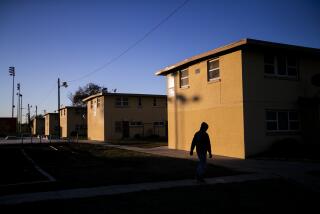Job of Water-Sniffing Team Can Be a Little Hard to Swallow
- Share via
Attention, water drinkers of Los Angeles. The weekly meeting of the Department of Water and Power’s “water-sniffer” team is now in session.
Present are Gary and Tom, sniff-team leaders. And sniffers Bill, Jay, Doug and Joe. They sit at a workbench inside the DWP water quality lab in Arleta, wearing white lab coats. Before them are beakers of DWP water samples and blue plastic cups.
Most days, they are biologists, chemists and engineers at the high-tech Arleta lab. But once a week, they become DWP’s Flavor Profile Analysis Team--known less bureaucratically as water sniffers.
To clear their palates (they taste as well as sniff), the team delicately nibbles Manischewitz crackers. They take careful sips of water, swishing them around their mouths. They stick their noses in the beakers, inhaling as intently as if they were part-owners of Chateau Lafite Rothchild.
Joe is not pleased.
“Yo, that smells grassy ,” he exclaims, recoiling a bit from his cup.
That’s not the only unsavory scent the DWP noses are on the alert for. There’s “bleachy,” “rancid,” “fruity” “fishy,” “woody” and the dreaded “septic.” The water also is tasted for too much chlorine or bitterness.
The sniffers further rate water on something called “mouth feel.” That category includes a number of characteristics you probably don’t want in your next cup of Earl Grey, like “oily,” “chalky” and “astringent.”
The sniffing and swishing continues. Suddenly, Bill, a florid-faced man who takes his job as seriously as a king’s beefeater, looks like he wants to spit his water into the nearest sink.
“Are you sure we’re supposed to drink Sample C?” he asks, suspicious that untreated water has accidentally been mixed with the regular stuff, as sometimes happens.
“I’m gonna get sick.”
As you may know, the DWP has had an image problem recently. In 1989, DWP surveys found that nearly two-thirds of its customers--and almost as high a percentage of DWP employees--used bottled water or water filters instead of drinking straight from the tap.
Fifty-four percent of customers who used bottled or filtered water said they did so for taste; 40% cited safety reasons such as fear of toxic pollution. The results were, in the words of one Times writer, “a stinging vote of no confidence” in DWP.
Like other water agencies, the DWP conducts exhaustive laboratory tests of its product for contaminants. But it has begun to realize the wisdom of checking for something that’s also important to customers: flavor.
“The department is getting a lot of, I guess, feedback from customers that we don’t address water on an aesthetic basis,” said Gary Bischop, the sniffers’ co-leader, choosing his words carefully.
Ergo, the sniffers. Formed about a year ago, their mission is simple: Test the water before customers start screaming that what’s coming out of their faucets tastes like it came out of somebody’s aquarium.
To become sniffers, Bischop and his cohorts underwent two weeks of intensive sniffology training at UCLA. Among other things, they had to smell their way through a 40-page scientific scratch ‘n’ sniff booklet, to make sure they weren’t anosmic--that is, that they couldn’t smell a feedlot at high noon in July.
Now, there’s something very comforting in all this. In our high-tech world of smart bombs and virtual reality, it’s reassuring that the human body can do some things better than the best machines. That, in some cases, even a lowly nose is preferable to a remote aquatic sensor.
What happens when the water sniffers turn up their noses at a particular sample? The team can recommend that a reservoir be taken out of service or a pipeline be flushed clean. DWP takes such actions when possible, as it did recently by shutting down Bouquet Reservoir, near Santa Clarita, after an algae bloom led to complaints of dirt smells in the water.
The sniffers rate odors on a scale of 1 to 4, with 4 being the strongest. A rating of Fishy 4 means, for instance, that the water generates an aroma about equal to that of a fresh tuna sandwich. Which is the level at which gagging customers light up the switchboards.
Of course, the media eats up the water-sniffers (what reporter could resist a bunch of DWP guys in lab coats sitting around sipping water like it was ’85 Cristal?), and DWP is hardly reluctant to show the team off.
On a recent morning, the sniffers went through their paces as two photographers and a reporter looked on and a DWP public relations agent hovered nearby.
Bischop, the leader, asked each sniffer how they rated six different samples.
“I got a Chlorine 2 and a Fruity 2,” said Bill of one sample. “Tutti-frutti.”
“Chlorine 1, Wood 1 and Straw or Hay 2,” said Jay.
“I also got a taste of fresh-ground pencil in there.”
After the session, Gary declared that the sniffers “didn’t really find anything out of the ordinary.” A whiff of hay and pencils never hurt anyone, apparently.
Jay was asked what the water really tasted like.
“Like water,” he shrugged, pushing a cart of beakers down the hall.


